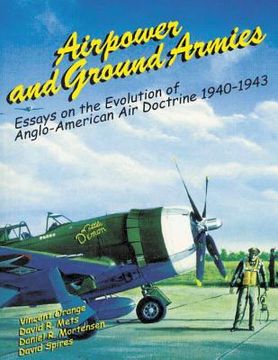Airpower and Ground Armies: Essays on the Evolution of Anglo-American Air Doctrine, 1940-43 (en Inglés)
Reseña del libro "Airpower and Ground Armies: Essays on the Evolution of Anglo-American Air Doctrine, 1940-43 (en Inglés)"
It was inevitable that the airman's perspective regarding the employment of airpower in an operational theater would surface in North Africa, the first major American offensive of World War II. The publication of Field Manuals (FM) 31-35, Aviation in Support of Ground Forces, and 100-20, Command and Employment of Air Power, was a manifestation of how airmen looked at the command of airpower, the selection of missions, and the assignment of priorities. The institutionalized conflict between soldiers and airmen over air employment that raised its head in Africa continues, regardless of the recorded combat experiences of, and the individual rapport among, field commanders. North Africa provided a stage to expose these deep-seated conflicting views of airpower. The soldier viewed the war in terms of brigades, divisions, corps, and armies; some saw the application of airpower as being in direct support of their own combat formations. The airman, on the other hand, saw the application of airpower in terms of the entire theater of operations; therefore, he saw it employed in situations and against enemy forces presenting the greatest threat in the theater. The establishment of three priorities for air missions-superiority, interdiction, and close air support- was a focus of his perspective of theater air operations. Historical experience greatly affected the advocacy of this theater-wide operational scheme, particularly the way airpower was initially commanded and employed in North Africa. Along with an air campaign needing a focus to gain control of the air and interdict the battlefield, there was a need to reorganize the command structure. In essence, the decision to establish a tactical and strategic air force under a single air commander (Northwest African Air Forces under Gen Carl A Spaatz) created a theater command structure with coequal air and ground commanders under Gen Dwight D. Eisenhower. By this arrangement, the air and ground component commanders received equal footing. Previously, tactical airpower was subordinated, thus limiting the ability of XII Air Support Command and RAF 242 Group to influence the determination of theater strategy, the employment of forces, and the assignment of priority in application. It is against this background that the long-standing ideas of airmen brightened, leading to the development and publication of FM 100-20 and, later, to revisions of the basic tactical doctrinal manual (FM 31-35). These manuals served the purpose, perhaps too shrilly in retrospect, of articulating what airmen believed about airpower and how their perspectives on its use related to the views of ground forces. These manuals continue even today to be the foundation of what airmen believe about airpower and its relationship to the other services in a combat theater. The North Africa experience provided a model for the organization and employment of tactical airpower in subsequent campaigns in Europe, Korea, Vietnam, and the Gulf War. In each of these campaigns, planners have continued to refine, expand, and improve the effectiveness of tactical air support for all forces in a theater. The priorities for employment are a function of the most pressing threat and the greatest opportunity for imposing a major effect on the fighting ability of the opposing forces. The flexibility of tactical air (its greatest asset) permits a shifting focus between air superiority, interdiction, and close air support in accordance with the priority established by the overall commander. Differences in opinion on the employment of forces will continue among air, ground, and sea commanders in combat situations. However, when the overall commander in the theater makes a decision on the strategy and priority of operations, the air component commander must and will apply his forces in accordance with that decision.

